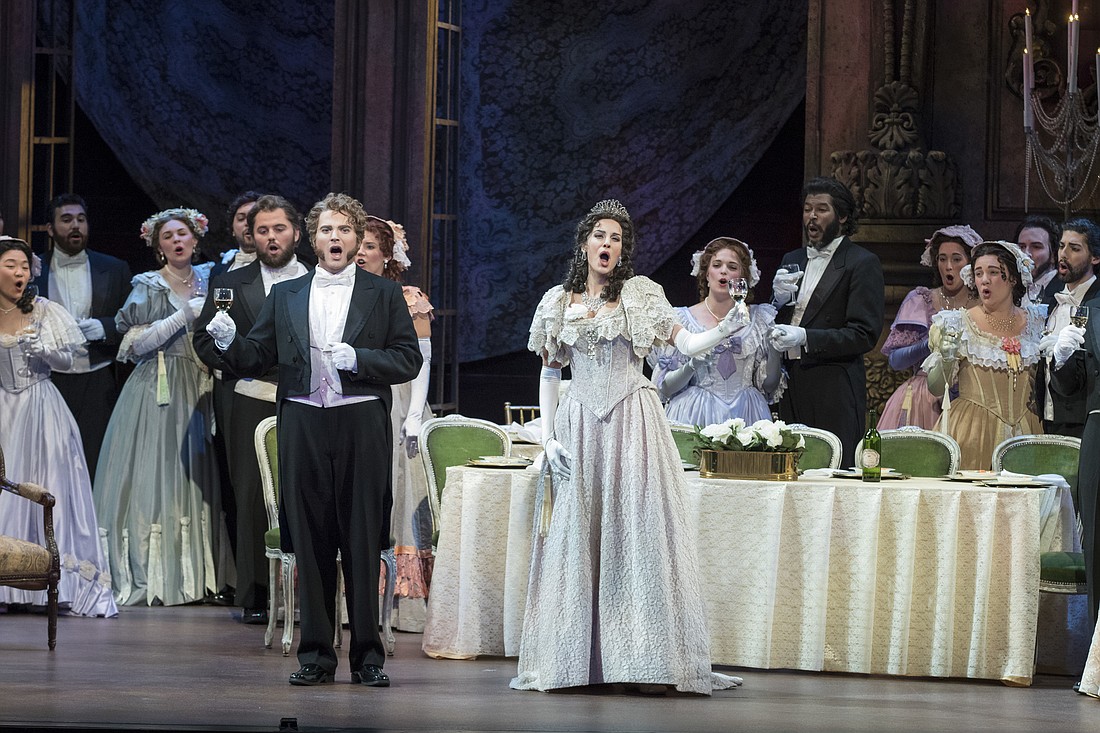- May 8, 2025
-
-
Loading

Loading

“Everything Old is New Again” was certainly the case when the Sarasota Opera opened its fall season with a stunning new production of Giuseppe Verdi’s ageless “La Traviata.”
After 28 years devoted to presenting every known note and opera written by this composer, the opera wisely took a brief Verdian hiatus last season, and his return to the repertoire was greeted by an enthusiastic capacity audience, eager for every note and nuance.
Based on Dumas’ “Lady of the Camellias,” the opera traces a tragic six months in the life of Violetta, a courtesan of the demi monde, who, suffering from consumption, finds true love in Alfredo — only to have their brief love shattered by his interfering father. After she is publicly humiliated by her renounced lover, she declines in health and spirit, only to be reunited and reconciled in her final moments as she expires in Alfredo’s arms.
Opera is first and foremost about good singing, and the three principal artists gave us that and much more. Verdi’s Violetta is a demanding role for any soprano, moving as it does from giddy coloratura in the first act through the drama of the second, to the agonizing weakness of the final scene. Elizabeth Tredent, who was most impressive in last season’s “Love of Three Kings,” proved more than equal to the task. She has a lovely lyric voice that she uses well, and her performance was both vocally lovely and dramatically convincing throughout the evening.
Tenor Andrew Surrena was an excellent Alfredo in both voice and movement, especially in his second act aria and cabaletta and in his duets with Violetta. Tredent and Surrena are both former apprentice and studio artists, showcasing both the quality of these programs and the loyalty of the Sarasota Opera to the careers of its young artists.
The role of Georgio Germont was ably portrayed by Sarasota Opera veteran Marc Nisticò, who is always an audience favorite. His voice, sounding just a bit dry at times, was perfect for the role of Alfredo’s father, and his subtle transition from antagonism to sympathy when he convinced Violetta to leave Alfredo was a highlight of the evening. His aria, “Di Provenza il mar” was beautifully sung, as well as were both verses of the cabaletta, which is often omitted.
All of the smaller vital roles were competently handled by studio and apprentice artists, led by Laurel Semerdjian as Flora and Jared A. Guest as the Baron Douphol. Stephen Martin as Gastone, Do Jin Jung as the Marquis D’Obigny, Anna Bridgman as Annina, Costas Tsourakis as Dr. Grenvil, Jake Skipworth as the messenger and Alexander Henderson as Flora’s servant rounded out the large cast.
The scenic world they inhabited, created by designer David Gant, featured a palette of opulent burgundies and black, dominated by a huge chandelier in Act I and a massive staircase in Flora’s house in Act II. Equally impressive were the settings for the lovers’ country place and Violetta’s sparsely furnished bedroom in the final act. Lighting was designed by Ken Yunker, who never fails to provide just the right touch to the mood of each scene.
Costumes were coordinated by Howard Tsvi Kaplan, who dressed his characters appropriately and with sartorial elegance, and hair and makeup were designed by Brittany Rappise in her Sarasota Opera debut.
Stephanie Sundine’s excellent stage direction created some beautiful tableaux and movement with the chorus, giving each of them a distinct personality. She provided the principal singers with a subtlety of character and movement not often seen in opera. Sundine expertly managed every detail from the elegant sit-down dinner of Act I to the staging of the usually superfluous Gypsy Chorus and “Matador’s Song” at Flora’s party in Act II, which was augmented with charming dance soloists from the Sarasota Cuban Ballet School, choreographed by Tania Vergara.
Artistic Director Victor DeRenzi conducted an excellent Sarasota Orchestra in a musically lovely performance, always moving the drama forward while producing a solid foundation for the singers. DeRenzi is a Verdi scholar, and he wisely restored all the cuts often made in “La Traviata.” These include not only the earlier-mentioned cabalettas of Alfredo and Germont in Act II, but also the second verses of all the arias, which, together with a bit of subtle ornamentation, was a most welcome surprise.
Aside from just a touch of opening-night-itis at the outset, the performance settled and then soared as the evening progressed. All in all, this performance of “La Traviata” was one of the best outings of the Sarasota Opera in recent memory. It runs through Nov. 21.
This one is special, don’t miss it!